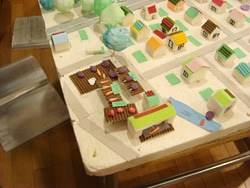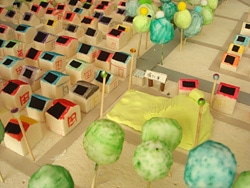



 |
| A vegetable stand located near the field allows residents to buy fresh local vegetables, showing how the children value their town's locally grown veggies. |
When children think about the future of their city, they hope for a place that values people's smiles, cities that are rich with green and comfortable, and cities that respect their natural surroundings. During November and December, 157 students from four sixth grade classes at Shichigo Elementary School in Sendai City used their integrated study period develop and present models that they had created depicting what their town, Shichigo, would look like in eight years. On 11 December, the presentation event was held with parents and local community members in attendance.
As part of its Child-Friendly Reconstruction Programme, the Japan Committee for UNICEF (JCU) supports various opportunities that aim to amplify the voice of children in urban development during the reconstruction process. Under the banner of this program, assistance for Shichigo Elementary School is being provided in a collaborative project with Professor Shinya Sato, an active practitioner in the field of residential and urban development studies from Yamagata University's Faculty of Education, Art and Science, as well as the Takenaka Corporation, a cornerstone of the project and the company that originally proposed "urban reconstruction together with children".
 |
| Black solar panels line house roofs, allowing them to store electricity for power generation during emergencies. A supply shelter can also be found on the street corner. |
Four future "city mayors" selected from four classes joined hands with 16 "ward mayors" to share ideas and build a town out of 16 bright and colorful panels. Sometimes the children actually ventured out into the town to visualize the future image of their townscape. Ms. Kamezaki, the head of the integrated studies class, said, "The materials provided to the children were very three-dimensional, so it was easy for them to be creative. Thank you very much."
A strong overarching theme of the children's models was the inclusion of environmental-friendliness; children included houses and streetlamps with solar panels, waterwheels that produce electricity for household use, a vegetable market located near the fields providing locals with easy access to fresh vegetables, bus stops equipped with sensors notifying persons waiting of approaching buses, cycling roads that contribute to preventing accidents, and a library with an environmentally-friendly green curtain. One girl smiled as she told JCU about the section she was in charge of, "It was really fun decorating the more detailed places."
 |
| The final masterpiece was formed by combing four individual sections. |
Yamagata University Professor Mr. Shinya Sato offered a heartwarming evaluation of the event: "This is very much a town linking people with their environment. It is also wonderful because it takes into account the disaster-preparedness perspective, ensuring safety against a potential tsunami. I was very impressed at the way the students took every care in their designs, ensuring that visually impaired people with guide dogs had a path for evacuation or that the entrance gates to the shrine were designed just perfect.
Each of the four classes prepared one proposed town section, and then the sections were combined to form a single masterpiece that allowed onlookers a view of four integrated towns. One of the children greeted the audience on behalf of the participants by saying, "We plan to work hard for the community so that in eight years from now we will have a town just like the model here." Her message indicated the children's strong will to actively work together with adults in the reconstruction process of building a new town.
All photo credits: © Japan Committee for UNICEF